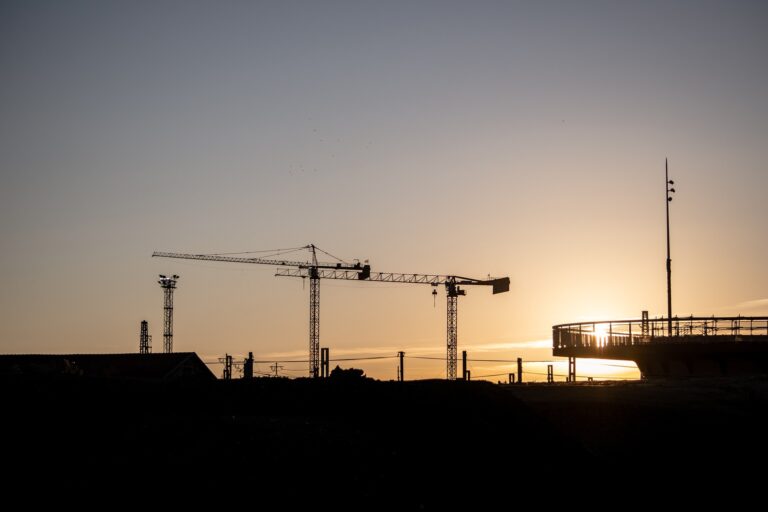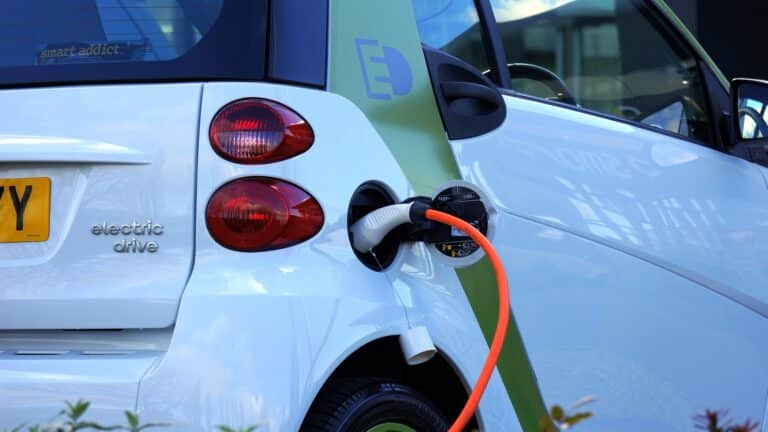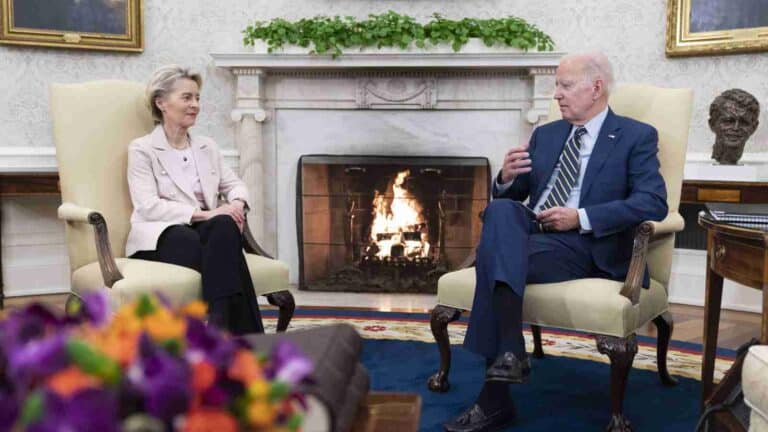Big banks predict catastrophic warming, with profit potential
Morgan Stanley, JPMorgan and an international banking group have quietly concluded that climate change will likely exceed the Paris Agreement's 2 degree
Current Access Level “I” – ID Only: CUID holders, alumni, and approved guests only
Head of Energy Technology Policy Division, International Energy Agency
Timur Gül [00:00:03] What we are recommending in our report, as well as that industrial strategy is that are going to be developed, need to build on a mapping of the domestic competitive strengths that each and every country or each and every region has and identify strategic partnerships that countries may wish to be pursuing in order to effectively benefit from and participate in that new energy economy.
Bill Loveless [00:00:28] Innovation and clean energy is accelerating. Batteries are getting denser and cheaper. Wind turbines are getting bigger and better, and new solar projects often generate the cheapest electricity in the world. Meanwhile, cutting edge technologies like hydrogen, electrolysis and direct air carbon capture keep improving Most of the world’s major economies The U.S., EU, India, Japan and China are racing to capture the economic benefits of this tech innovation through deployment incentives and support of domestic manufacturing. But bottlenecks for critical minerals supply chain constraints from COVID and fierce competition among countries are all potential hurdles for this new industrial age. So where is clean energy innovation advancing the fastest? And how will competition over manufacturing shake out in the decade ahead? This is Columbia Energy Exchange, a weekly podcast from the Center on Global Energy Policy at Columbia University. I’m Bill Loveless. Today on the show, Timur Gül is the head of the Energy Technology Policy Division at the International Energy Agency. He is the lead on the Energy Technology Perspectives Report. The flagship series serves as the world’s first global guidebook for the clean technology industries of the future. The 2023 version was just released earlier this month. Timur gave me an insider’s look into the report. We discussed how the key findings fit into the current geopolitical atmosphere of energy markets, and we talked about the major opportunities both globally and domestically, for technology innovation. Here is our conversation. Teamwork. Good. Welcome to Columbia Energy Exchange.
Timur Gül [00:02:27] Thank you very much, Bill. Pleasure to be here.
Bill Loveless [00:02:29] Well, I look forward to discussing this report. And as will acknowledge, it’s very timely with the meetings in Davos and just general interest in this subject. But first, tell us a little bit about your background, your work, and how you got into this field.
Timur Gül [00:02:47] Yeah. So I’m the head of the Energy Technology Policy Division here at the International Energy Agency, which is an organization in charge of energy security, environmental aspects, energy affordability, energy, anything that is really dealing with energy markets and policies as a government organization. It’s a team. My team is looking into new and emerging technologies across the full range of energy related sectors, from the production to transformation of energy to the use of energy and transport industries and and buildings. I’ve been with the IEA now for a good 14 years and was first working on the World Energy Outlook team and became the head of the technology division in 2018. My background is in engineering, so I’m an environmental engineer by education with with master degrees from Germany and from Sweden and a Ph.D. from from Switzerland.
Bill Loveless [00:03:55] Yeah. The World Energy Outlook, of course, is the flagship there at the International Energy Agency. And as I understand it too, you adopt or share some of the same techniques in assembling these reports.
Timur Gül [00:04:08] Yes, indeed. We have four we have one big energy systems model that that we are employing with various different techniques, optimization tools, simulation tools. So all the type of modeling techniques that we can deploy in order to get the best possible insights. We used to maintain two separate models for many years. But in the context of our net zero by 2050 roadmap that we released just about two years ago, we decided that it’s time for merging the best of the two worlds in order to bring the best possible technology and policy insights, market insights tool to the world more broadly.
Bill Loveless [00:04:51] Well, this report, this new report, Technology Report, opens by stating that the energy world is in the early phase of a new industrial age, an age of clean energy technology, manufacturing. What does that mean.
Timur Gül [00:05:06] As a good. It’s a good question. But I think what what we try to reflect here is the fact that technologies that are industries that were in their infancy just about 20 years ago, such as solar PV and wind energy or in the 20 tens or just about ten years ago, Such electric cars or batteries have really become vast manufacturing operations as of today. And what we are seeing really is that there’s much more to come. When you look at the latest IEA forecasts that we do for the for the next five years for solar PV, solar PV has already been the largest source of capacity additions in the power sector for six years in a row now and is now set to surpass coal in capacity terms within the next five years towards 2027. And for electric cars, which is in many ways one of the most dynamic areas of clean energy today, Sales have exceeded 10 million last year and reached around 13% of all vehicles sold just last year. So these are very unprecedented rates of deployment for these, but also for other clean energy technologies that we looked into in our report. And they’re driving really what we think of as an overhaul of the global industrial sector and its technology supply chains, from mining to mineral processing to material production and then to manufacturing operations. So this is really what we have done in our report is a look at the entire value chain, the clean energy technologies, supply chains for a variety of different technologies. And what we’re really seeing is that there is a new industrial age of clean tech manufacturing coming towards us, driven in part by climate goals, of course, as the main driver historically for going into clean energy technologies. But now in the context of the current energy crisis, also very much by energy security concerns and in the long term by affordability questions. So there is really a big push towards clean energy technologies. And of course they don’t just come to us these technologies, they have to be manufactured and that’s. Where we’re seeing that new age of industrial, of this new industrial age coming towards us.
Bill Loveless [00:07:29] You know, before we dig deeper into the report, it’s important to note the substantial attention that this topic and this report has been receiving this week at the World Economic Forum in Davos. What do you make of that?
Timur Gül [00:07:43] Well, it just shows me that we’ve been we found the right timing for this particular report. On the one hand, so this is very much good news for us. So we’ve started to plan for this report about a year ago, actually, before Russia’s invasion of Ukraine, before the Inflation Reduction Act was implemented in the United States and before the US. Various other governments have been moving towards shaping up their industrial strategies. But it also tells me that many governments, as well as industries, are actually seeing that there is a real opportunity in that new energy economy that is emerging, that it’s not only about that challenge of meeting climate goals, but there is a real tangible market opportunity coming up. And the fact that leaders in Davos, industry leaders, government leaders are picking up on these type of discussions tells me that we have found enough here. When we were released, our report.
Bill Loveless [00:08:50] You know, there is a global market opportunity for key mass manufactured clean energy technologies the report says is worth around $650 billion a year by the year 2030. And that’s more than three times today’s level. And and it depends upon countries worldwide fully implementing their announced energy and climate pledges. But there are potentially risky levels of concentration in clean energy supply chains, both for manufacturing and for the materials in which they rely. These findings may not come as a surprise. This is a topic that’s been discussed a whole lot for some time now, but their importance is undeniable. Remind us of what’s taking place.
Timur Gül [00:09:35] So what’s taking place is that, as I said, and as you just rightly pointed out, there are climate pledges that governments have put put in place around the world are driving an overhaul of the way we consume and produce energy. Those $650 billion is in mass manufactured technology, solar PV on an offshore wind, the components, batteries, its components, etc. etc. electrolyzers. So we looked into many of them and the importance here is that the supply chains, that it’s not only about deploying the technologies, but it’s also about building out supply chains that are secure and that are resilient and that ultimately also are sustainable. And this is what is what has motivated our report initially. And what we have found is that there are very varying degrees of concentrations in many parts of the supply chains already today, not only in critical minerals mining that is often the focus of supply chains discussions, but also really in the processing of critical minerals, in the production of a materials such as aluminum, such as steel, such as cement, etc.. And importantly in technology manufacturing. What our report is in many ways is I think to the best of my knowledge, the first really comprehensive assessment of all these clean energy technology supply chains. And we’ve been able to sort of collecting information not only about the present day of a geographical concentration, but also by collecting information about company announcements. Where where are they planning to invest, How much are they trying to invest into different manufacturing facilities in these different mass manufacture of factory technologies? We’ve been able to shape up and good understanding and a picture of how the future might look like if these manufacturing plants come to fruition. And I think this is a very important input at this point in time for policymakers that are looking to position themselves, their economies, their industrial actors in the right place. So in order to build a secure, resilient and sustainable supply chains.
Bill Loveless [00:12:07] So again, the findings themselves are not surprising. They’re not even necessarily new, but the extent to which they’re explored in this report is is different. Is that is that what you’re saying?
Timur Gül [00:12:19] Yeah, I think I’m not sure they are not. Necessarily a new. I think what. What I think we have seen analysis of individual technology areas and we ourselves last year released two reports already in the run up to this report, one on solar PV supply chains and one on electric vehicle supply chain. So we have done extensive literature research on that, data research on that. But I think what it does is it helps to understand all these various different facets that come with different supply chains. And I think in that regard, it’s not only comprehensive and in that case novel, but also it offers a depth of understanding of these supply chains that I don’t think has been there so far.
Bill Loveless [00:13:10] Interesting. You know, among the many striking illustrations in the report is one showing regional shares of manufacturing capacity for clean energy technologies and components in the year 2021. The chart is awash in the color red for China, with some measure of green for the U.S. and blue for Europe, as well as other colors for other regions. This this says a lot, right?
Timur Gül [00:13:34] It does say a lot. Yes, it does say a lot. It tells you that China has been investing in manufacturing capacity for a long time. It is for for reasons of investment, for reasons of deploying. And China has been deploying technologies and energy across the full range of energy technologies for the last two decades or so. So investment took place in that country. And it tells you that many countries currently have to start catching up in order to tap into the opportunity that comes with that new and emerging economy that I was describing earlier.
Bill Loveless [00:14:14] And yet, is there the potential to catch up in many of these manufacturing areas and as well as in supplies or, you know, have some regions, some countries have fallen so far behind, say China, that there’s not much ground to be gained.
Timur Gül [00:14:34] I think there is a lot of ground still to be gained. I think if you look at the net zero transition that the countries are signing themselves up for in our own net zero by 2050 road map, we are describing a transition towards a full overhaul of the energy sector compatible with a 1.5 degrees goal. And we need a full range of clean energy technologies and a whole range of different sector. What we have looked at, as I said, is also the announced manufacturing projects. And what you see there is that there is a huge amount or huge project pipeline for such manufacturing projects coming up, but only a fraction of them is already under construction today or is beginning to begin in construction imminently. 25% of the announced manufacturing projects for solar PV, 35% for EV batteries, less than 10% for ELECTROLYZERS. So there is still a lot to be gained in that new and emerging economy. And ultimately building out more of that will only help us put it put ourselves in a better position to meet climate goals. Having said that, I think it is also important for countries to review what is their relative competitive strengths that they are having that are strength that come with the place that you are in. In the supply chain today. There are strengths that come with energy costs that you have in your in your country, resource endowments. And there are strengths that come with the size of your domestic market, your your skill sets among your workforce, your research capabilities within within your country, etc.. Also, there is a lot of opportunity still for countries to catch up. It might not be and the manufacturing of the technology itself, but it could be in the manufacturing of components, for example, that are part of the technology at the very end.
Bill Loveless [00:16:40] You know, the concentration of manufacturing can keep prices down, as we’ve seen with China’s mass production of solar components. But lately, we’re seeing tight supply chains contribute to increases in the cost in supply chains, making the clean energy transition more difficult for countries.
Timur Gül [00:17:00] Yes, that’s right. These supply chain disruptions have to come to backgrounds if you want. They they started with the pandemic. The pandemic has led to a lot of disruptions in various different supply chains, not only clean energy technology related, but also in various different others. Russia’s invasion of Ukraine has certainly amplified these these kind of problems. And what we’ve been seeing in the recent past and last year in particular, is that for technologies like EV batteries, where prices have been fallen for years and years and years in a row, we saw that the prices for the first time actually increased. But that’s not something that will stay forever. Technology will continue to improve. So making the relative costs of the technology being a bit less vulnerable to to some extent to commodity price changes, innovation can also help to shift technology from one to another, meaning that the the the commodities that are required for producing them could actually change, making them, again, less vulnerable to commodity price changes. So there is a lot that can be done in the in the long term. But yes, in the near-term we’re certainly seeing an increase in the price of technology. But this is not unique to clean energy technology alone. Of course, fossil prices have also been on the rise over the course of last year.
Bill Loveless [00:18:33] You know, we spoke of Davos, the World Economic Forum taking place there at this gathering. The Fatih Birol, the executive director of the IEA, said the energy crisis sparked by Russia’s invasion of Ukraine has become the biggest driving force behind the growth of renewable energy, overtaking the desire to reduce emissions. What did he mean by that?
Timur Gül [00:18:59] What we mean is that, I mean, think of Europe. Europe is basically has been importing huge amounts of coal, huge amounts of oil and juice from huge amounts of gas from Russia until 24th of February last year. And Europe is now working strongly to reduce its oil to cope with the fact that there is no further import of natural gas coming from Russia. And as it looks, there will not be a resurgence of gas imports in particular from from Russia. So we need alternatives here in Europe and they are ready. They are ready made alternatives with clean energy technologies, renewables here in particular. When you think of the last energy crisis in the 1970s, the last big, big energy crisis, oil crisis in the 1970s, we had technology available, but really not that much more in comparison with today. There was a scale up of nuclear energy. There were improvements in energy efficiency for passenger vehicles in particular. But today we have renewables. We have many more more efficient technologies. We have electric cars. So there is a whole range of clean energy technologies that can be deployed. And what we have just recently done is we have made a huge increase in our forecast for renewables installations in particular in Europe, driven by the fact that governments are pushing renewable energy technologies as a means to deal with the lack of natural gas imports from Russia. And I think that is a huge cause for optimism when it comes for clean energy technology, clean energy transitions.
Bill Loveless [00:20:50] Yeah, You mentioned the role that governments policies play, as has a Fatih Birol. When when the IEA released this technology report this month, he said, quote, The era of clean technology manufacturing means every country needs to develop an industrial strategy that reflects its strengths and addresses areas where it’s less competitive and countries have been in regions have been doing just that, including the U.S., with the Inflation Reduction Act and the European Union, with an announcement at Davos that it would mobilize state aid and so a serenity fund to keep firms from moving to the United States. A lot of discussion there of industrial policy and how it applies to clean energy manufacturing.
Timur Gül [00:21:38] Yes, I think many countries are moving that that way right now. I think if you develop your industrial strategy, you need to start out. I mean, not that it’s not realistic that every country participates effectively in all supply chains and competes effectively across all steps of each of the supply chains. So for us, what we are recommending in our report, as well as that industrial strategy is that are going to be developed, need to build on a mapping of the domestic competitive strengths that each and every country or each and every region has and identify strategic partnerships that countries may wish to be pursuing in order to effectively benefit from and participate in that new energy economy. And as I said, not every country can do everything here, and it is very good to see how industrial strategies are being developed in different countries. But there is also a very lively exchange on how partnerships can actually be built moving forward.
Bill Loveless [00:22:44] Yeah, and maybe you can help us understand the usefulness of the conversations that are taking place at Davos on this topic, because so often this discussion is is political, right? You’re not a political scientist, So I wouldn’t ask you to comment on the politics of this issue. But but nevertheless, that’s the way it’s often framed. You know, Senator Joe Manchin, whose vote was crucial to the passage of the Inflation Reduction Act in Washington, made the rounds at Davos and defending the IRA, sometimes to less than receptive audiences. And, you know, Europe’s the European Commission president, Ursula von der Linde, you know, talked about these new policies, additions to policy in the EU to take into consideration what the United States was doing. She said at one point, quote, The story of the clean tech economy will be written in Europe, but you see usefulness in these these exchanges, these discussions that have taken place at the forum.
Timur Gül [00:23:47] I think it is. I think we have to we have to consider two elements here. One is what we want to do domestically as we’re building our industrial strategy is we need to see what is what is possible domestically and what is what is not possible domestically. Take hydrogen as an example. Today we are producing hydrogen somewhere at cost of 1 to $3 per kilogram and renewable electricity based hydrogen through electrolyzers in most regions of the world is just simply not competitive. But when countries are pushing forward their climate pledges of obviously renewable electricity costs will continue to fall. Electrolyzer costs will fall, hydrogen storage costs will fall. And yet what what is often being thought of is that the cost will be so, so low that it will compete with fossil based hydrogen. That is suddenly what we are expecting as well. But yet it doesn’t mean that you compete with fossil based hydrogen, that you can compete with renewable hydrogen from other countries around the world. And so that has repercussions. So what we are seeing is that the costs in Western Europe and Japan will continue to be higher than it will be in the United States, China, India and elsewhere, which has repercussions on the commodities that we are producing from them. Steel, for example, where the cost of production of hydrogen based steel using renewable electricity is said to be higher in Europe and and in Japan than it is in those countries that I mentioned earlier. So conversations will need to take place here on how partnerships are developed. How should we produce hydrogen domestically? Should we import it should produce other elements of the supply chain instead ammonia or other derivatives. These are the kind of discussions that need to take place now. And so it’s very good to see that this is actually happening.
Bill Loveless [00:25:57] Yeah, Yeah, that’s been interesting. I think that’s been one of the interesting developments of this particular meeting. And Ira has certainly come up a lot. But as I have noticed, Birol also called the IRA the greatest climate agreement since the 2015 Paris Accord. So I think there’s an acknowledgment that while while there may be aspects of the Inflation Reduction Act, that some countries may not be comfortable with, its impact is certainly being recognized.
Timur Gül [00:26:24] Very much so, Yeah, I think very much so. And I think the fact that Europe is establishing an industrial strategy here as well just goes to show that countries are looking to tap into the opportunity of manufacturing, tapping into the opportunity of the new energy economy. And that can only help us as a as a world to meet our climate goals. And in the long term, I think it’s the right move forward.
Bill Loveless [00:26:52] You know, there’s been good news regarding the diversification of supply with the recent announcement of a discovery of the major Earth mineral deposits in Sweden, the largest such discovery in Europe, the equivalent of more than 1 million metric tons of rare earth oxides. That said, the actual mining and delivery of raw materials from the mine site may take 15 or at least 10 to 15 years, according to the CEO of the company that would do the work. What do you make of that announcement?
Timur Gül [00:27:25] I think it’s one of these points that are important to understand and for the clean energy transition. Indeed, how how long are the lead times to develop different parts of the supply chains? Indeed, on the mining side, it will certainly take ten years or so, sometimes 15 years, to develop mines and bring rare earths or other critical minerals forward into the global market in order to help diversify supply chains. On the manufacturing side, the lead times are much, much shorter, so it takes 1 to 3 years to build a new manufacturing facility. So diversification here can can be much quicker and in fact, than it can be on the mining side. That’s why one of the recommendations of our report is as well as to ensure that investment in mining takes place as soon as possible because it will take, regardless of the will, the political will of the country as. Will take time, physically take time until these mines and related supply chains can actually be developed. But it’s an important contributor to the long term resilience of clean energy technologies. Supply chains. Nonetheless.
Bill Loveless [00:28:46] What do you look at this studies done it was it took some time to complete. But your work is is never, ever ends. Having completed this effort, what sorts of things will you be tracking now?
Timur Gül [00:29:01] While we’ll certainly be tracking continue to be tracking announcements for manufacturing capacity, for technology manufacturing, I think that is that is very obvious. But we are also currently trying to see how our report resonates where countries, our member governments and beyond have a particular interest for us to dive deeper. I could imagine questions such as regional competitiveness, the mapping of industrial opportunities that interest every country might have, and to identify strategic opportunities for or strategic partner opportunities for strategic partnerships are a couple of key areas that I would imagine could be of interest here. What we are currently doing is to bring this report and its findings into as many important fora as we possibly can. Our executive director was in Davos, as you mentioned earlier. He brought the messages there and we are now working to present our work to different governments around the world. And then we will see where we can help further understanding countries or helping countries to understand their place in the new energy economy that is emerging and what kind of actions they may wish to be taking.
Bill Loveless [00:30:23] How soon might this report be? Another edition of this report come out?
Timur Gül [00:30:28] We are currently working on two reports for the G7, one on industrial decarbonization and one on hydrogen. So we have a lot on our plate, but we will see. I can’t I can’t put a date to that, unfortunately.
Bill Loveless [00:30:42] Yeah, it’ll be interesting to look back at some point and maybe we have to wait a period of years to see how the concentration of manufacturing or the distribution of manufacturing and the supply chains as well see some modification. I mean, again, when you look at this report and where you see the numbers there, as we said before, they’re not necessarily new, but they’re striking. You know, the three largest producer countries account for at least 70% of manufacturing capacity for technologies like wind batteries, electro electrolyzers solar panels and heat pumps. And the geographical distribution of critical mineral extraction is is is so concentrated. For example, Congo alone produces 70% of the world’s cobalt, and just three countries account for more than 90% of global lithium production. I don’t know if do we see major changes in those sorts of numbers, say five years from now, eight years from now or so?
Timur Gül [00:31:43] So I think on the on the mining side of things, the geographical concentration is obviously mandated by resource endowment. So and given the lead times that I described earlier, it will take time until any of that can change and only within certain margins. I think when it comes to this present decade, China has clearly found a way best place to tap into the technology manufacturing, part of the supply chains that has most of the current announcements for manufacturing capacity expansion too, of solar PV components, 85% for cells and modules, 90% for wafers. It has most of the current announcements for wind components for onshore. Wind, for example, is around 84 or 5% for blades, around 90% for Nestle’s and towers and similarly for EV battery components where the majority of the announcements is also in China. So I think. A fundamental change in the way this picture looks today, in the next five years is a challenge. But it doesn’t necessarily mean that there will be changes. If you think about Electrolyzers, for example, the picture is much more diverse. China and Europe each hold around one quarter of announced manufacturing capacity for 2030, another 10% being in the United States. And we’re going to see how the impacts of the IRA will shape up here and various others. As I said, I think it takes a bit of time to build these facilities, but not so long. So there is still opportunity to tap into those opportunities.
Bill Loveless [00:33:31] You know, opinions vary regarding the outlook for clean energy technologies, given given the opportunities and challenges. Again, at Davos and in a panel with the young activist Greta Thunberg. Fatih Birol said, quote, We can have slight legitimate optimism regarding the adoption of renewable energy. You know, noted the amount of renewables coming to market last year was was at a record high. How do you feel?
Timur Gül [00:33:58] I’m feeling optimistic. Generally speaking, yes. I’m at the I suppose, as you said before, I’m probably not the political scientist, but I’m an engineer and I believe in technology change. I think technology has a lot of and innovation has a lot a lot to offer to help build a cleaner energy economy. The question is always at which timescales I’ll be operating here. And obviously net zero by 2050 is certainly on a global scale, is a is a tall order in terms of the deployment needs that we have and whether or not we’re going to be able to make it is the key challenge here. If you think about some of the announcements of battery manufacturing, for example, as very close to the needs of a net zero by 2050 pathway. And also we’re very close to the manufacturing needs by 2030. Same for solar PV. In other areas we are falling short of course, but I think the the current context in which the climate, climate change imperative, energy security concerns and industrial opportunities are coming together makes me feel optimistic about the pace of the clean energy transition, whether or not it helps us to or whether we manage to get to net zero by 2050 is of course, something that will need to be seen. But at least from a technology perspective, what we’ve seen in the past, what we are seeing currently moving forward, leaves me still optimistic.
Bill Loveless [00:35:35] Well, that’s encouraging, given your understanding of this issue and the deep research you and your colleagues at the IEA have done on it. The report is the Energy Technology Perspectives from the International Energy Agency. Timur Gül, thank you so much for taking the time on today on Columbia Energy Exchange to walk us through the report, end to end to put into perspective this this important issue.
Timur Gül [00:35:59] Thank you very much for having me. Bill has been a great pleasure.
Bill Loveless [00:36:05] Thank you again, Timur Gül and thanks to all of you for listening to Columbia Energy Exchange. The show is brought to you by the Center on Global Energy Policy at Columbia University’s School of International and Public Affairs. The show is hosted by Jason Bordoff and me Bill Loveless. The show is produced by Stephen Lacy and Erin Hartig of Postscript Media. Additional support from Daniel Prop, Natalie Volk and Kyu Lee. Roy Campanella is the sound engineer. For more information about the podcast or the Center on Global Energy Policy, visit us online at Energy Policy dot Columbia dot edu or follow us on social media at Columbia U. Energy. And if you like what you heard, consider giving us a rating on Apple Podcasts. It helps the show reach more listeners like yourself. We’ll see you next week.
Innovation in clean energy is accelerating. Batteries are getting denser and cheaper; wind turbines are getting bigger and better, and new solar projects often generate the cheapest electricity in the world.
Meanwhile, cutting-edge technologies like hydrogen electrolysis and direct-air carbon capture keep improving.
Most of the world’s major economies – the US, EU, India, Japan, and China – are racing to capture the economic benefits of this tech innovation through deployment incentives and support of domestic manufacturing.
But bottlenecks for critical minerals, supply chain constraints from Covid, and fierce competition among countries are all potential hurdles for this new industrial age.
Where is clean energy innovation advancing the fastest? And how will competition over manufacturing shake out in the decade ahead?
This week host Bill Loveless talks with Timur Gül.
Timur is head of the Energy Technology Policy Division at the International Energy Agency and leads the Energy Technology Perspectives report. The flagship series serves as the world’s first global guidebook for the clean technology industries of the future. The 2023 version was just released earlier this month.
Timur gives us an insider’s look into the report. He and Bill discuss how the key findings fit into the current geopolitical atmosphere of energy markets. They also talk about the major opportunities both globally and domestically for technology innovation.
The European Union’s energy landscape is transforming rapidly, as the bloc works to reduce emissions, lower energy prices, and decrease dependence on Russian fuel—three goals proving to be...

Across America, energy policy is often driven by short-term politics over long-term planning. Despite record-breaking U.S. oil production in recent years, partisan battles continue over fossil fuels and...

Last week, energy industry leaders gathered in Houston for CERAWeek by S&P Global, one of the most important annual industry events focusing on the current state of energy...

Energy and climate change are becoming ever more central to America's national security. It used to be that foreign policy and national security discussions related to energy focused...



On March 31, the US Treasury Department issued guidance on tax incentives for vehicle batteries and minerals under the Inflation Reduction Act (IRA). Among other features, the new...
